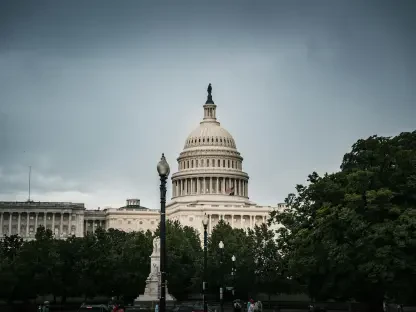In the ever-evolving financial landscape, investors are increasingly focused on strategic decisions that can provide protection against market volatility. Navigating this landscape requires discerning the right mix of assets that can withstand economic fluctuations. As traditional paths such as U.S. Treasurys come back into favor with improved yields, investors are recalibrating their approaches to risk and return. Emerging markets, in particular, present opportunities as these regions offer potential gains fueled by local growth dynamics and currency plays. In this context, understanding the insights of financial leaders like Eric Stein of Voya Investment Management offers crucial guidance for those looking to safeguard their portfolios amidst global uncertainties.
Re-Evaluating Treasury Duration as a Strategic Hedge
Revived Role of U.S. Treasurys
In recent years, the use of Treasury duration as a hedge against equity market volatility has seen renewed interest among investors. Previously, U.S. Treasurys were less attractive due to persistently low yields. However, current economic conditions have shifted, and Treasurys now offer more appealing yields, providing a buffer against potential downturns. In situations where recession looms, Treasurys often experience falling yields, making them a stable refuge against more volatile equity and credit markets. Such protective value is particularly crucial in an environment where other asset classes suffer due to heightened risk perceptions.
The ability of Treasurys to act as a hedge is further underscored when geopolitical tensions or policy changes spark uncertainty. Investors have started recognizing the need to reallocate resources to benefit from higher returns tied to fiscal policy adjustments. As such, the strategic importance of U.S. government securities has been somewhat revitalized. This repositioning within investment portfolios not only highlights the shifting economic landscape but also the enduring appeal of Treasurys as a cornerstone of fiscal stability during turbulent times.
Addressing Market Dynamics and Policy Implications
Another pertinent consideration is the impact of market dynamics and fiscal policies that shape the effectiveness of Treasury duration. As the macroeconomic backdrop evolves, factors such as inflation, growth projections, and central bank decisions significantly influence investment choices. Notably, assessments of inflation and its anticipated rise can affect yields and curb potential gains from fixed-income securities. Understanding these aspects is vital for deploying Treasury strategies that are both timely and adaptive to ongoing shifts.
The change in yields spells beneficial opportunities, as market players witness a pivot towards more dynamic fiscal approaches. The adoption of these strategies aligns well with prevailing conditions marked by economic recovery prospects and variable central bank stances. Here, the role of investor sentiment cannot be overstated, as it drives the movement of bonds and varying risk premiums. Investors should remain vigilant to ensure that their hedging strategies and market expectations are aligned to optimize returns and resilience against unanticipated adjustments in policy directions.
Opportunities in Emerging Markets and Local-Currency Investments
Harnessing Emerging Market Potential
Emerging markets, displaying unique growth patterns and economic potential, have become attractive destinations for investors aiming to diversify portfolios beyond traditional assets. As developed markets reach maturity, the vibrancy of emerging economies, driven by expanding consumer bases and industrial innovation, offers unparalleled prospective gains. In particular, local-currency debt in these regions provides a compelling opportunity for those anticipating a weaker U.S. dollar. A depreciating dollar can enhance the value of these local-currency investments, offering a dual benefit of currency appreciation along with interest income.
Investors are increasingly attracted to securitized and structured products within these markets, which reap benefits from higher yields and less correlation with developed market volatility. Economic conditions in developing countries often diverge from those in established markets, presenting a hedge against global shocks. The prospects for these investments are bolstered by supportive government policies and demographic shifts leading to robust demand growth. Thus, emerging markets pave the way for portfolio enhancement while capturing extensive upside potential linked to regional economic advancements.
Navigating Risks and Geopolitical Realities
While emerging markets afford lucrative prospects, they are not without risks that need careful navigation. Political instability, regulatory shifts, and exposure to external shocks, such as fluctuations in commodity prices, can significantly affect returns. Consequently, a sophisticated understanding of geopolitical realities and local economic conditions forms the basis for informed investment decisions. Investors must be adept at pricing such risks effectively, which remains a complex aspect due to ever-changing market conditions. Moreover, gradual decision-making processes can help mitigate the implications of rapid, ill-considered moves during uncertain times.
Institutional investors, with their structured approaches and analytical rigor, may find themselves well-equipped to tackle these challenges. Their processes, while slower, allow for a comprehensive evaluation of risks and rewards, enabling strategic positioning amidst economic uncertainties. Emerging markets remain a vital component of diversified portfolios, as they continue to evolve and present opportunities not constrained by the complex dynamics often experienced in more established economies. By integrating emerging market investments with stable, traditional assets, investors can leverage both growth prospects and risk mitigation for balanced portfolio strategies.
Balancing Traditional and Alternative Asset Classes
The Role of U.S. Assets in a Volatile World
The global economic landscape continues to witness substantial shifts, prompting an assessment of traditional and alternative asset classes. Despite the seeming restriction of alternatives to U.S. assets due to geopolitical and economic instability, these assets remain central to hedge against multiple uncertainties. U.S. assets serve as the bedrock of financial stability, offering assurance during volatile periods, thanks to advanced market structures and underlying economic strengths. Even as fiscal policy undergoes scrutiny, the attractiveness of U.S. securities remains upended by the comparative paucity of global alternatives.
Investors recognize that, while other markets provide attractiveness in isolation, the systemic reliability of U.S. assets persists, acting as an anchor amid destabilizing forces. Therefore, maintaining a balance by incorporating reliable U.S. assets alongside explorative alternatives creates a framework for managing not only risks but also capturing diverse opportunities. Investing strategies thus embody a layered approach encompassing robust safety nets within the strategy to buffer against various market contingencies.
Exploring Emerging Market Alternatives
In today’s rapidly changing financial environment, investors are increasingly concentrating on making strategic choices that shield them from market swings. Success in this area hinges on identifying a blend of assets adept at weathering economic instability. U.S. Treasurys, historically reliable, are increasingly favored due to higher yields. This shift signifies a broader re-evaluation of risk and potential return strategies. In contrast, emerging markets offer lucrative opportunities driven by local economic growth and currency fluctuations. For contemporary investors, insights from industry experts like Eric Stein of Voya Investment Management are invaluable to fortify portfolios against global uncertainties. Stein’s perspectives help investors understand how to adjust their tactics for a more resilient approach amidst ongoing economic shifts. In an era where unpredictability is the norm, leaning on the expertise of financial leaders can provide not just security but also the potential for substantial gains, even in the face of adversity.









